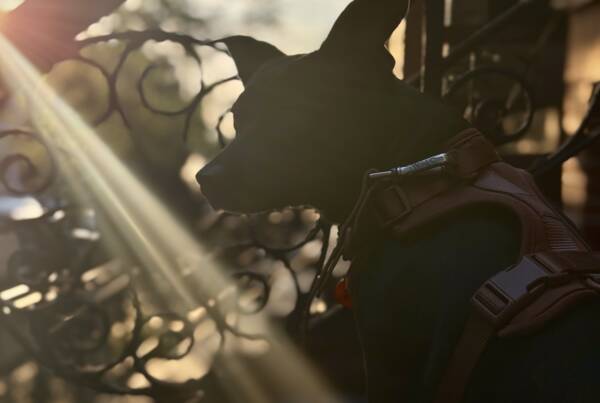Writing by Ashlynn Hannah
It was a balmy autumn night when artist Jade Lees-Pavey had the opening night of her exhibition titled Difficult Woman? at the Queen Victoria Women’s Centre (QVWC). The feminist-influenced artist found her and her art a home at the QVWC with its rich women’s history over the 170 years it has sat at the heart of the city.
Lees-Pavey used her exhibition as a platform to take social issues of inequities she was witnessing on social media and in our society and translate them to her art in the form of political messaging. Through her lens of feminism, her exhibition artwork took on the forms of word block assemblage, paintings, and sculptures.
The maker’s shop located inside the QVWC is a space for women and non-binary artists to display their work with a focus on feminism. On the shelves you will find Lees-Pavey’s ceramic mug collection titled Little Acts of Rebellion which represents the connection between her creative process as an artist and the issues she cares about.
“The activism hasn’t always been there for me,” explains Lees-Pavey.
“It’s been a slow burn, and then I happened upon those cups that I make, and I felt more confident because people liked them,” she says.
“I called them little acts of rebellion because that’s how I felt and I thought if I feel this way, then maybe someone else feels this way.”
Lees-Pavey’s role as a mother comes hand-in-hand with her position as a feminist. She reflects that as her children grew more independent, it made room to tune her mind to social issues happening around her and to make the conscious decision to call herself a feminist.
“I wanted to move with the time,” she says.
“I could have stayed stuck,”
“I could have stayed rooted in ideas.”
Lees-Pavey is not someone defined by her age. She goes to university wearing a purple jacket with various pins carefully fixed to her collar. A pink and purple-hued pin displays a raised fist, a historical display of unity for different social causes. She acquired this pin last year around the time Roe v Wade was overturned in America, echoing the ongoing fight for abortion rights, and the long way to go in fighting sexism.
Studying printmaking she quickly made the connection between the art form and how it lent itself to rebellion and protest due to its fast and repetitive nature.
It was in 2016 when Donald Trump was elected as US president that Lees-Pavey put her printmaking experience to use and created a print called Grab Back inspired by the millions of women wearing pink knitted beanies called ‘pussy hats’ in protest of Trump and his statements about women.
“My way of being involved was to create art that I could disseminate through the internet,” she says.
Halle Brown is not unlike Jade Lees-Pavey in her approach to using art as a form of activism, but the subject matter of Brown’s art comes from a much more personal place. While Lees-Pavey’s artwork is predominantly influenced by external issues surrounding her, Brown’s pieces are an insight into the internal happenings of her female body.
Growing up in Horsham in regional Victoria, Brown described herself as fitting the category of the “weird art kid”. Her love of art sparked in high school from an encouraging teacher, however, it was a few years later and after a diagnosis of polycystic ovarian syndrome (PCOS) that her art elevated to a new level.
The term ‘difficult woman’ has been associated with women for centuries for being bold, emotional and not afraid to say no. In the 19th century, female hysteria was a commonly diagnosed physical illness for a wide array of symptoms such as irritability or simply a loss of appetite for food or sex. Brown recalls learning about hysteria and its use as a cover diagnosis for anything out of the ordinary happening to a woman and likened it to her experience of how she felt during her long-awaited diagnosis of PCOS.
“Women were not being believed with their medical problems,” she says.
“Which led me on to exploring my experience with my body and my experience with the medical system and PCOS.”
The contraceptive pill is a commonly prescribed medication for people with PCOS which Brown was taking to deal with her hormones until she got a blood clot in her left thigh.
She recalls feeling stuck in limbo as she could no longer take the pill which was “like a cure-all” for helping with her PCOS symptoms, until she came across the IUD.
“The concept of the IUD was terrifying, but I knew it was really my only other option,” she says.
“In the time before my appointment I sort of built up the idea of the IUD as my last hope, my saviour and then I intertwined that with religious imagery in my art.”
Brown’s journey with PCOS is interwoven with her artistic process. There is something very intimate about Brown’s work which is online for others to admire, but at its core is an outlet she uses to process her emotions and the feminine rage she feels brewing inside her.
“Basically, all my art is intensely feminist. I use a lot of feminine imagery,” says Brown.
Raising awareness and taking away the stigma around weight gain due to PCOS is important to Brown who highlights just how beautiful a PCOS body is through her art.
“My body is the only thing I will ever occupy,” she says.
“I can’t put myself into another vessel.
“This is my being. It’s my body. I need to come to terms with that and embrace the only thing I’ll ever exist in.”
To learn more about the Queen Victoria Women’s Centre, visit their website here.
To learn more about polycystic ovary syndrome (PCOS), head here.
Support local artists by visiting Jade Lees-Pavey’s website here and Halle Brown’s website here.
Jade Lees-Pavey’s Instagram: @jadeleespaveyartist
Halle Brown’s Instagram: @rasberryh










